Theoretical Foundations of Advanced Practice Nursing Presentation
VerifiedAdded on 2022/09/27
|5
|1583
|35
Presentation
AI Summary
This presentation explores the theoretical foundations of advanced practice nursing (APN), focusing on the application of conceptual frameworks, models, and theories to enhance patient care and professional practice. The presentation begins with an introduction to the importance of theories, frameworks, and models in guiding evidence-based practice, understanding factors influencing practice, and evaluating nursing practice. It then delves into the PEPPA framework, highlighting its role in APN role development and implementation. The presentation also discusses the professional practice model (PPM), emphasizing its components and contribution to nursing practice. Furthermore, it examines Henderson's needs theory, outlining its key concepts and practical applications in patient-centered care. The presentation concludes by integrating these elements through a graphical representation and summarizing how these theories and models can be used to enhance the legitimacy of the nursing profession and improve patient outcomes. The presentation uses the provided references from different authors to support the points and findings.
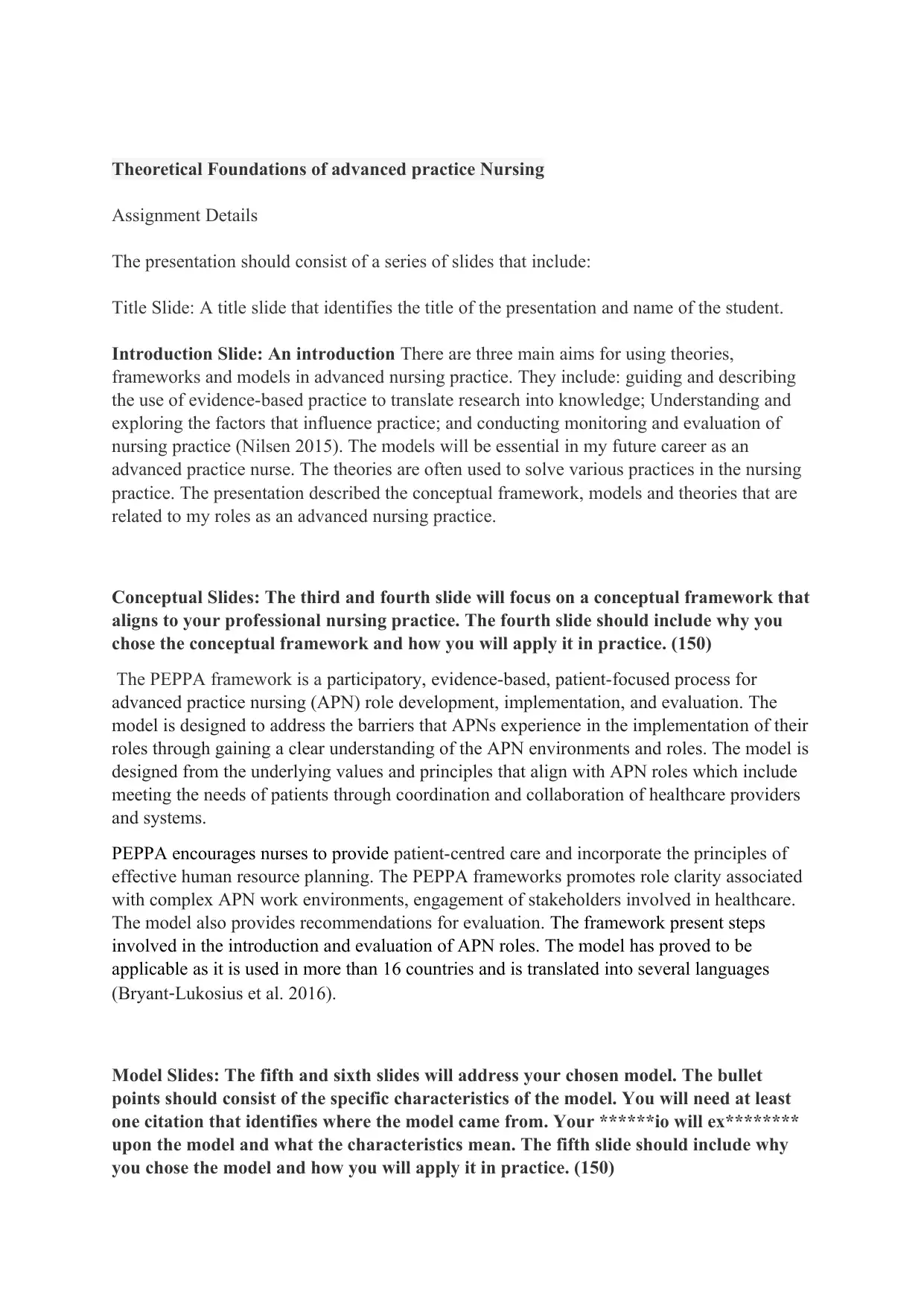
Theoretical Foundations of advanced practice Nursing
Assignment Details
The presentation should consist of a series of slides that include:
Title Slide: A title slide that identifies the title of the presentation and name of the student.
Introduction Slide: An introduction There are three main aims for using theories,
frameworks and models in advanced nursing practice. They include: guiding and describing
the use of evidence-based practice to translate research into knowledge; Understanding and
exploring the factors that influence practice; and conducting monitoring and evaluation of
nursing practice (Nilsen 2015). The models will be essential in my future career as an
advanced practice nurse. The theories are often used to solve various practices in the nursing
practice. The presentation described the conceptual framework, models and theories that are
related to my roles as an advanced nursing practice.
Conceptual Slides: The third and fourth slide will focus on a conceptual framework that
aligns to your professional nursing practice. The fourth slide should include why you
chose the conceptual framework and how you will apply it in practice. (150)
The PEPPA framework is a participatory, evidence-based, patient-focused process for
advanced practice nursing (APN) role development, implementation, and evaluation. The
model is designed to address the barriers that APNs experience in the implementation of their
roles through gaining a clear understanding of the APN environments and roles. The model is
designed from the underlying values and principles that align with APN roles which include
meeting the needs of patients through coordination and collaboration of healthcare providers
and systems.
PEPPA encourages nurses to provide patient-centred care and incorporate the principles of
effective human resource planning. The PEPPA frameworks promotes role clarity associated
with complex APN work environments, engagement of stakeholders involved in healthcare.
The model also provides recommendations for evaluation. The framework present steps
involved in the introduction and evaluation of APN roles. The model has proved to be
applicable as it is used in more than 16 countries and is translated into several languages
(Bryant‐Lukosius et al. 2016).
Model Slides: The fifth and sixth slides will address your chosen model. The bullet
points should consist of the specific characteristics of the model. You will need at least
one citation that identifies where the model came from. Your ******io will ex********
upon the model and what the characteristics mean. The fifth slide should include why
you chose the model and how you will apply it in practice. (150)
Assignment Details
The presentation should consist of a series of slides that include:
Title Slide: A title slide that identifies the title of the presentation and name of the student.
Introduction Slide: An introduction There are three main aims for using theories,
frameworks and models in advanced nursing practice. They include: guiding and describing
the use of evidence-based practice to translate research into knowledge; Understanding and
exploring the factors that influence practice; and conducting monitoring and evaluation of
nursing practice (Nilsen 2015). The models will be essential in my future career as an
advanced practice nurse. The theories are often used to solve various practices in the nursing
practice. The presentation described the conceptual framework, models and theories that are
related to my roles as an advanced nursing practice.
Conceptual Slides: The third and fourth slide will focus on a conceptual framework that
aligns to your professional nursing practice. The fourth slide should include why you
chose the conceptual framework and how you will apply it in practice. (150)
The PEPPA framework is a participatory, evidence-based, patient-focused process for
advanced practice nursing (APN) role development, implementation, and evaluation. The
model is designed to address the barriers that APNs experience in the implementation of their
roles through gaining a clear understanding of the APN environments and roles. The model is
designed from the underlying values and principles that align with APN roles which include
meeting the needs of patients through coordination and collaboration of healthcare providers
and systems.
PEPPA encourages nurses to provide patient-centred care and incorporate the principles of
effective human resource planning. The PEPPA frameworks promotes role clarity associated
with complex APN work environments, engagement of stakeholders involved in healthcare.
The model also provides recommendations for evaluation. The framework present steps
involved in the introduction and evaluation of APN roles. The model has proved to be
applicable as it is used in more than 16 countries and is translated into several languages
(Bryant‐Lukosius et al. 2016).
Model Slides: The fifth and sixth slides will address your chosen model. The bullet
points should consist of the specific characteristics of the model. You will need at least
one citation that identifies where the model came from. Your ******io will ex********
upon the model and what the characteristics mean. The fifth slide should include why
you chose the model and how you will apply it in practice. (150)
Paraphrase This Document
Need a fresh take? Get an instant paraphrase of this document with our AI Paraphraser
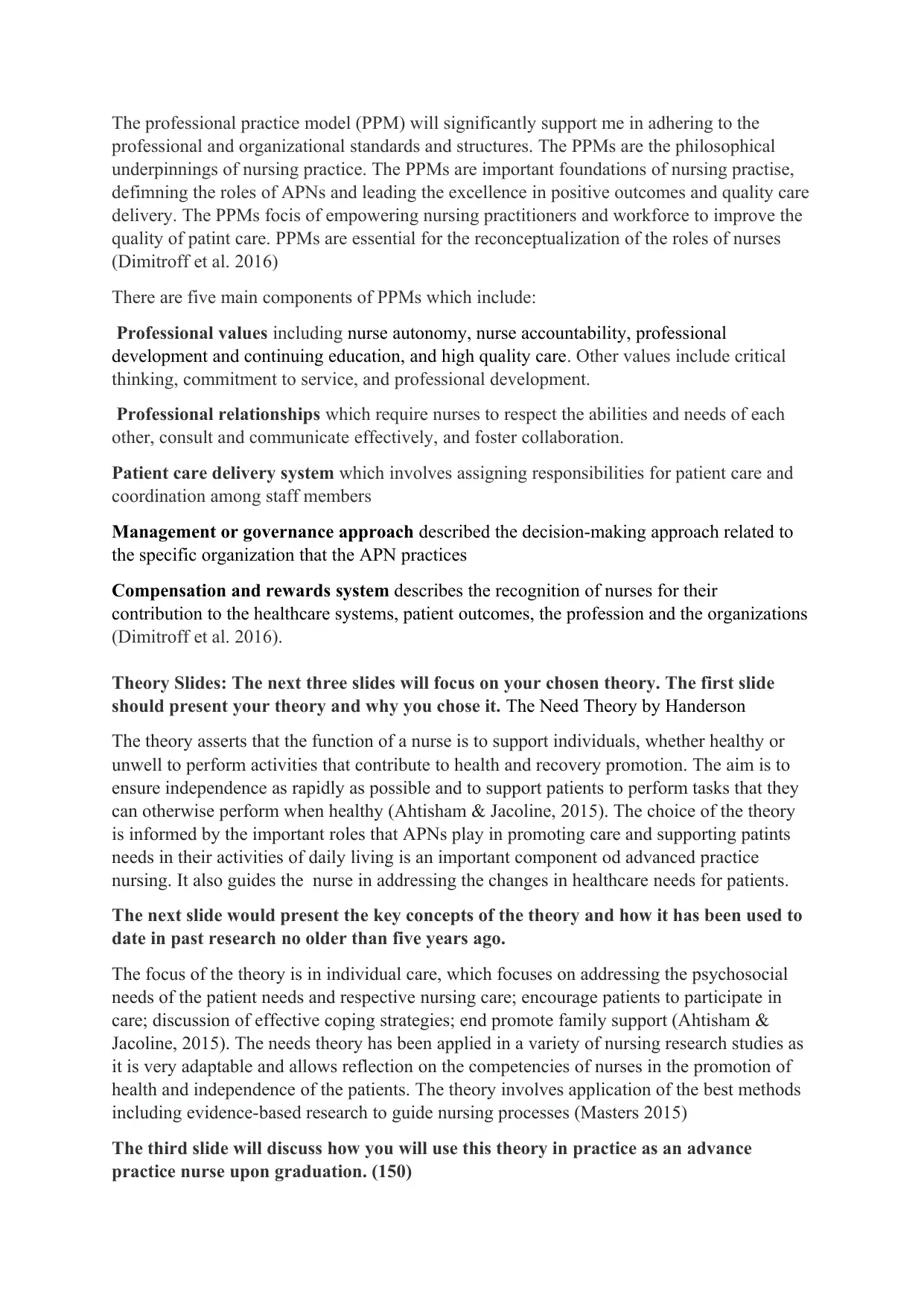
The professional practice model (PPM) will significantly support me in adhering to the
professional and organizational standards and structures. The PPMs are the philosophical
underpinnings of nursing practice. The PPMs are important foundations of nursing practise,
defimning the roles of APNs and leading the excellence in positive outcomes and quality care
delivery. The PPMs focis of empowering nursing practitioners and workforce to improve the
quality of patint care. PPMs are essential for the reconceptualization of the roles of nurses
(Dimitroff et al. 2016)
There are five main components of PPMs which include:
Professional values including nurse autonomy, nurse accountability, professional
development and continuing education, and high quality care. Other values include critical
thinking, commitment to service, and professional development.
Professional relationships which require nurses to respect the abilities and needs of each
other, consult and communicate effectively, and foster collaboration.
Patient care delivery system which involves assigning responsibilities for patient care and
coordination among staff members
Management or governance approach described the decision-making approach related to
the specific organization that the APN practices
Compensation and rewards system describes the recognition of nurses for their
contribution to the healthcare systems, patient outcomes, the profession and the organizations
(Dimitroff et al. 2016).
Theory Slides: The next three slides will focus on your chosen theory. The first slide
should present your theory and why you chose it. The Need Theory by Handerson
The theory asserts that the function of a nurse is to support individuals, whether healthy or
unwell to perform activities that contribute to health and recovery promotion. The aim is to
ensure independence as rapidly as possible and to support patients to perform tasks that they
can otherwise perform when healthy (Ahtisham & Jacoline, 2015). The choice of the theory
is informed by the important roles that APNs play in promoting care and supporting patints
needs in their activities of daily living is an important component od advanced practice
nursing. It also guides the nurse in addressing the changes in healthcare needs for patients.
The next slide would present the key concepts of the theory and how it has been used to
date in past research no older than five years ago.
The focus of the theory is in individual care, which focuses on addressing the psychosocial
needs of the patient needs and respective nursing care; encourage patients to participate in
care; discussion of effective coping strategies; end promote family support (Ahtisham &
Jacoline, 2015). The needs theory has been applied in a variety of nursing research studies as
it is very adaptable and allows reflection on the competencies of nurses in the promotion of
health and independence of the patients. The theory involves application of the best methods
including evidence-based research to guide nursing processes (Masters 2015)
The third slide will discuss how you will use this theory in practice as an advance
practice nurse upon graduation. (150)
professional and organizational standards and structures. The PPMs are the philosophical
underpinnings of nursing practice. The PPMs are important foundations of nursing practise,
defimning the roles of APNs and leading the excellence in positive outcomes and quality care
delivery. The PPMs focis of empowering nursing practitioners and workforce to improve the
quality of patint care. PPMs are essential for the reconceptualization of the roles of nurses
(Dimitroff et al. 2016)
There are five main components of PPMs which include:
Professional values including nurse autonomy, nurse accountability, professional
development and continuing education, and high quality care. Other values include critical
thinking, commitment to service, and professional development.
Professional relationships which require nurses to respect the abilities and needs of each
other, consult and communicate effectively, and foster collaboration.
Patient care delivery system which involves assigning responsibilities for patient care and
coordination among staff members
Management or governance approach described the decision-making approach related to
the specific organization that the APN practices
Compensation and rewards system describes the recognition of nurses for their
contribution to the healthcare systems, patient outcomes, the profession and the organizations
(Dimitroff et al. 2016).
Theory Slides: The next three slides will focus on your chosen theory. The first slide
should present your theory and why you chose it. The Need Theory by Handerson
The theory asserts that the function of a nurse is to support individuals, whether healthy or
unwell to perform activities that contribute to health and recovery promotion. The aim is to
ensure independence as rapidly as possible and to support patients to perform tasks that they
can otherwise perform when healthy (Ahtisham & Jacoline, 2015). The choice of the theory
is informed by the important roles that APNs play in promoting care and supporting patints
needs in their activities of daily living is an important component od advanced practice
nursing. It also guides the nurse in addressing the changes in healthcare needs for patients.
The next slide would present the key concepts of the theory and how it has been used to
date in past research no older than five years ago.
The focus of the theory is in individual care, which focuses on addressing the psychosocial
needs of the patient needs and respective nursing care; encourage patients to participate in
care; discussion of effective coping strategies; end promote family support (Ahtisham &
Jacoline, 2015). The needs theory has been applied in a variety of nursing research studies as
it is very adaptable and allows reflection on the competencies of nurses in the promotion of
health and independence of the patients. The theory involves application of the best methods
including evidence-based research to guide nursing processes (Masters 2015)
The third slide will discuss how you will use this theory in practice as an advance
practice nurse upon graduation. (150)
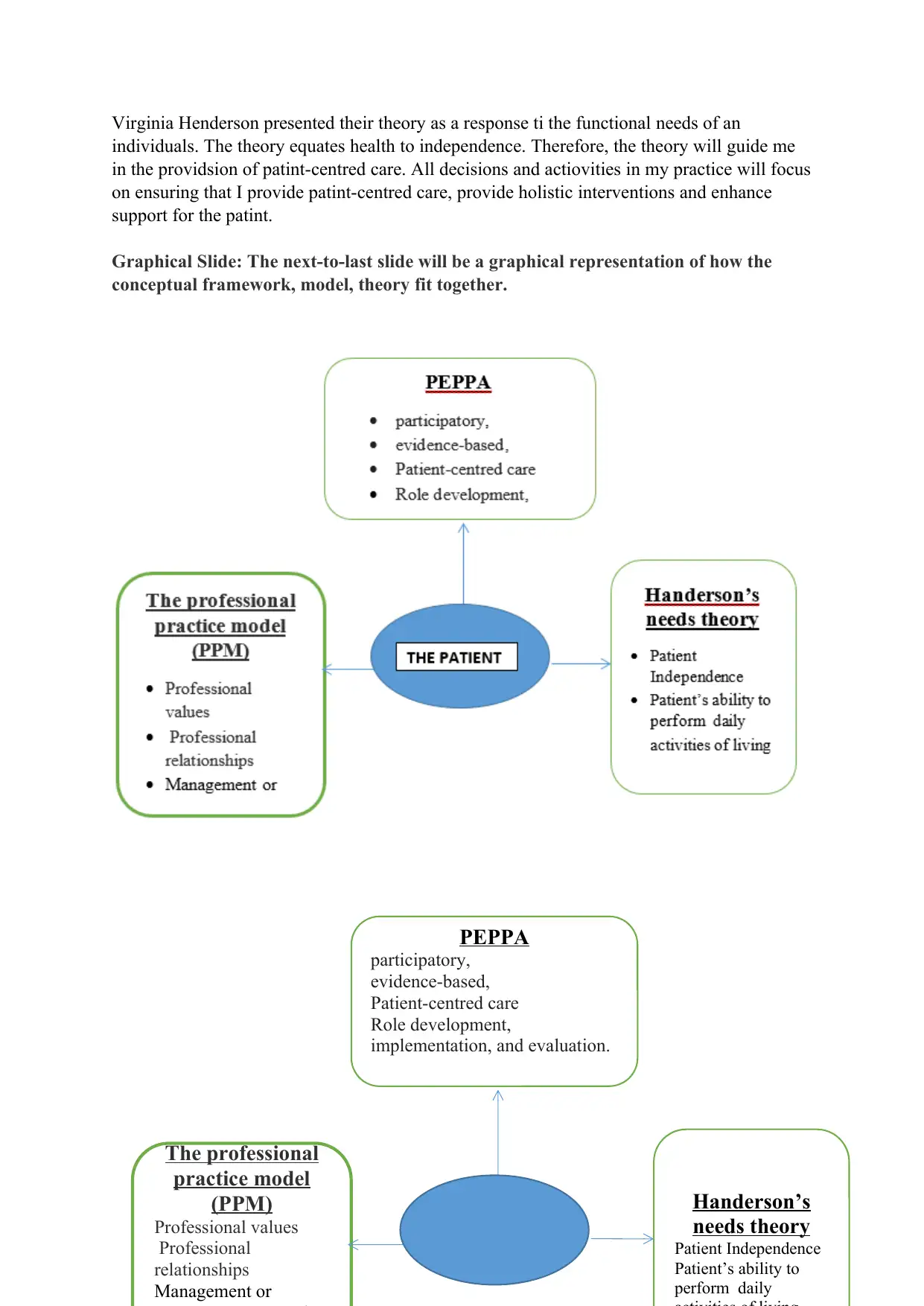
Virginia Henderson presented their theory as a response ti the functional needs of an
individuals. The theory equates health to independence. Therefore, the theory will guide me
in the providsion of patint-centred care. All decisions and actiovities in my practice will focus
on ensuring that I provide patint-centred care, provide holistic interventions and enhance
support for the patint.
Graphical Slide: The next-to-last slide will be a graphical representation of how the
conceptual framework, model, theory fit together.
PEPPA
participatory,
evidence-based,
Patient-centred care
Role development,
implementation, and evaluation.
The professional
practice model
(PPM)
Professional values
Professional
relationships
Management or
Handerson’s
needs theory
Patient Independence
Patient’s ability to
perform daily
individuals. The theory equates health to independence. Therefore, the theory will guide me
in the providsion of patint-centred care. All decisions and actiovities in my practice will focus
on ensuring that I provide patint-centred care, provide holistic interventions and enhance
support for the patint.
Graphical Slide: The next-to-last slide will be a graphical representation of how the
conceptual framework, model, theory fit together.
PEPPA
participatory,
evidence-based,
Patient-centred care
Role development,
implementation, and evaluation.
The professional
practice model
(PPM)
Professional values
Professional
relationships
Management or
Handerson’s
needs theory
Patient Independence
Patient’s ability to
perform daily
⊘ This is a preview!⊘
Do you want full access?
Subscribe today to unlock all pages.

Trusted by 1+ million students worldwide
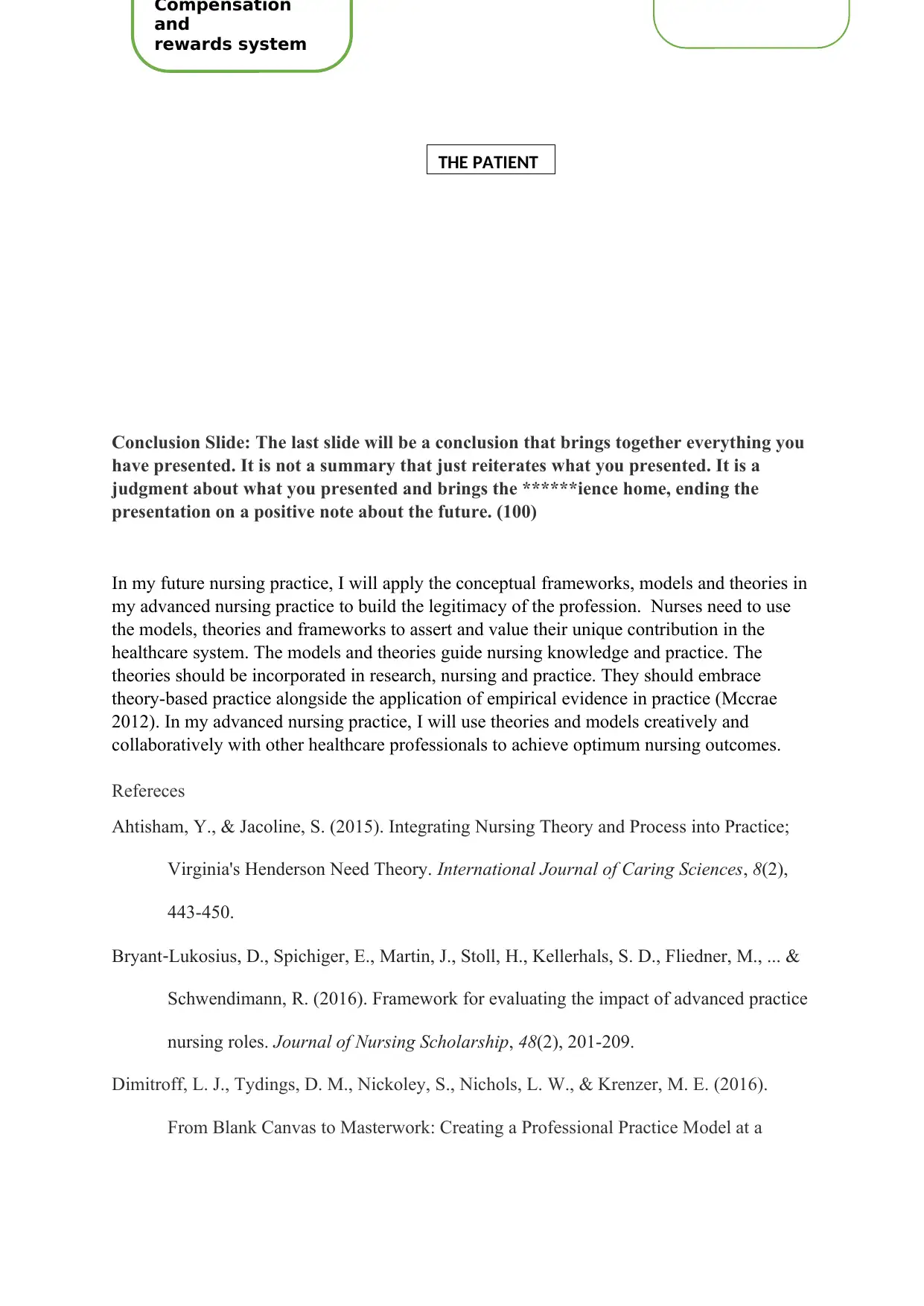
Conclusion Slide: The last slide will be a conclusion that brings together everything you
have presented. It is not a summary that just reiterates what you presented. It is a
judgment about what you presented and brings the ******ience home, ending the
presentation on a positive note about the future. (100)
In my future nursing practice, I will apply the conceptual frameworks, models and theories in
my advanced nursing practice to build the legitimacy of the profession. Nurses need to use
the models, theories and frameworks to assert and value their unique contribution in the
healthcare system. The models and theories guide nursing knowledge and practice. The
theories should be incorporated in research, nursing and practice. They should embrace
theory-based practice alongside the application of empirical evidence in practice (Mccrae
2012). In my advanced nursing practice, I will use theories and models creatively and
collaboratively with other healthcare professionals to achieve optimum nursing outcomes.
Refereces
Ahtisham, Y., & Jacoline, S. (2015). Integrating Nursing Theory and Process into Practice;
Virginia's Henderson Need Theory. International Journal of Caring Sciences, 8(2),
443-450.
Bryant‐Lukosius, D., Spichiger, E., Martin, J., Stoll, H., Kellerhals, S. D., Fliedner, M., ... &
Schwendimann, R. (2016). Framework for evaluating the impact of advanced practice
nursing roles. Journal of Nursing Scholarship, 48(2), 201-209.
Dimitroff, L. J., Tydings, D. M., Nickoley, S., Nichols, L. W., & Krenzer, M. E. (2016).
From Blank Canvas to Masterwork: Creating a Professional Practice Model at a
Compensation
and
rewards system
THE PATIENT
have presented. It is not a summary that just reiterates what you presented. It is a
judgment about what you presented and brings the ******ience home, ending the
presentation on a positive note about the future. (100)
In my future nursing practice, I will apply the conceptual frameworks, models and theories in
my advanced nursing practice to build the legitimacy of the profession. Nurses need to use
the models, theories and frameworks to assert and value their unique contribution in the
healthcare system. The models and theories guide nursing knowledge and practice. The
theories should be incorporated in research, nursing and practice. They should embrace
theory-based practice alongside the application of empirical evidence in practice (Mccrae
2012). In my advanced nursing practice, I will use theories and models creatively and
collaboratively with other healthcare professionals to achieve optimum nursing outcomes.
Refereces
Ahtisham, Y., & Jacoline, S. (2015). Integrating Nursing Theory and Process into Practice;
Virginia's Henderson Need Theory. International Journal of Caring Sciences, 8(2),
443-450.
Bryant‐Lukosius, D., Spichiger, E., Martin, J., Stoll, H., Kellerhals, S. D., Fliedner, M., ... &
Schwendimann, R. (2016). Framework for evaluating the impact of advanced practice
nursing roles. Journal of Nursing Scholarship, 48(2), 201-209.
Dimitroff, L. J., Tydings, D. M., Nickoley, S., Nichols, L. W., & Krenzer, M. E. (2016).
From Blank Canvas to Masterwork: Creating a Professional Practice Model at a
Compensation
and
rewards system
THE PATIENT
Paraphrase This Document
Need a fresh take? Get an instant paraphrase of this document with our AI Paraphraser
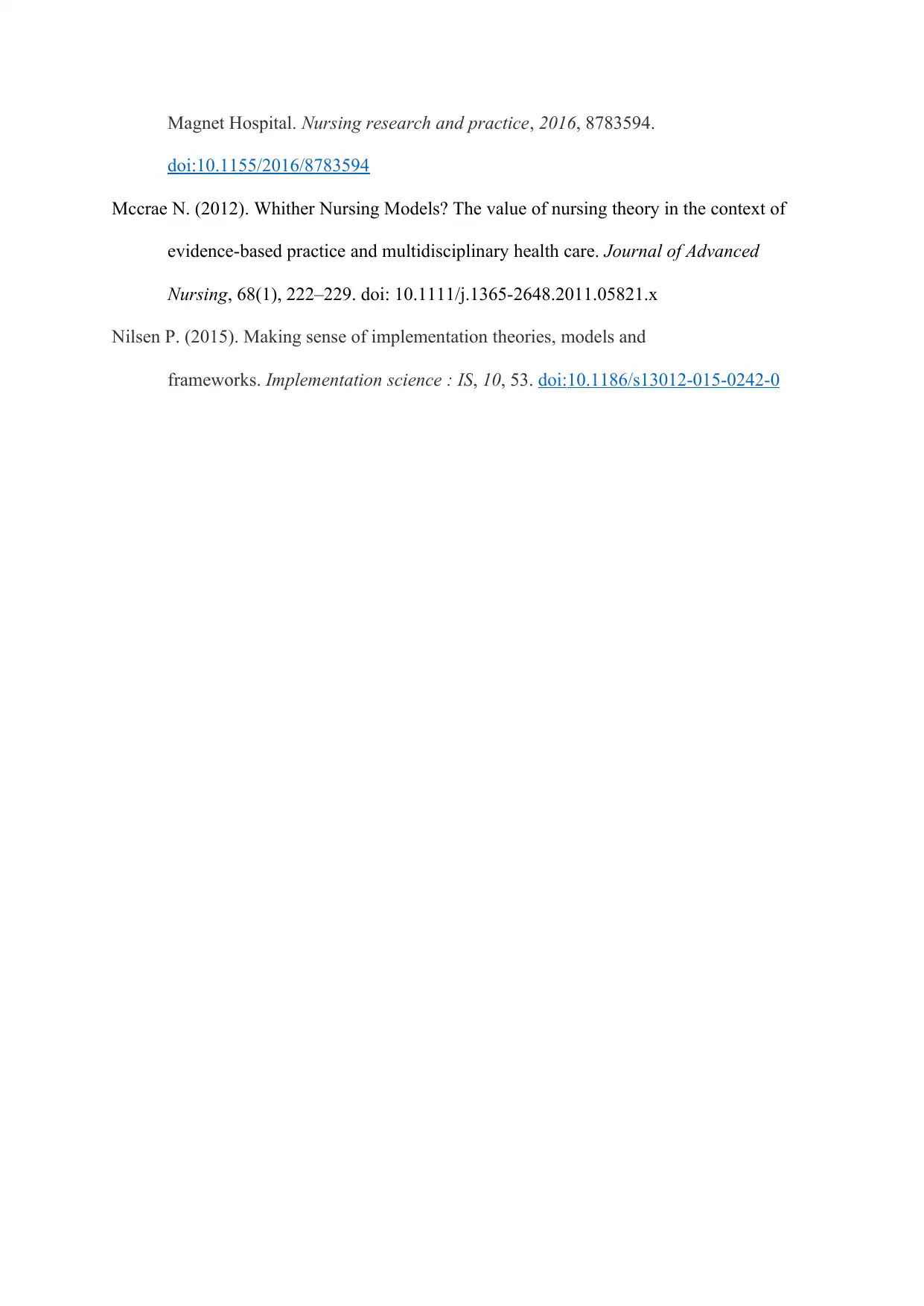
Magnet Hospital. Nursing research and practice, 2016, 8783594.
doi:10.1155/2016/8783594
Mccrae N. (2012). Whither Nursing Models? The value of nursing theory in the context of
evidence-based practice and multidisciplinary health care. Journal of Advanced
Nursing, 68(1), 222–229. doi: 10.1111/j.1365-2648.2011.05821.x
Nilsen P. (2015). Making sense of implementation theories, models and
frameworks. Implementation science : IS, 10, 53. doi:10.1186/s13012-015-0242-0
doi:10.1155/2016/8783594
Mccrae N. (2012). Whither Nursing Models? The value of nursing theory in the context of
evidence-based practice and multidisciplinary health care. Journal of Advanced
Nursing, 68(1), 222–229. doi: 10.1111/j.1365-2648.2011.05821.x
Nilsen P. (2015). Making sense of implementation theories, models and
frameworks. Implementation science : IS, 10, 53. doi:10.1186/s13012-015-0242-0
1 out of 5
Related Documents
Your All-in-One AI-Powered Toolkit for Academic Success.
+13062052269
info@desklib.com
Available 24*7 on WhatsApp / Email
![[object Object]](/_next/static/media/star-bottom.7253800d.svg)
Unlock your academic potential
Copyright © 2020–2025 A2Z Services. All Rights Reserved. Developed and managed by ZUCOL.





